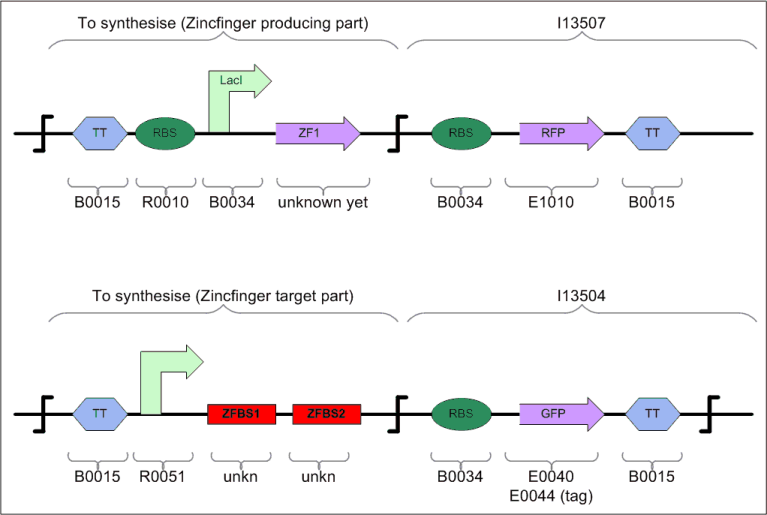4-State Device
From 2006.igem.org
Back to the ETH Zurich main page.
Contents |
Organisation
Group Members
- Alexander Roth(coordinator) Urs A. Müller Simon Barkow Tamara Ulrich Robin Künzler
Meetings
2005.08.17, Wednesday, 15:30 @ Alex' bureau (CAB F62) Summary 2005.08.18, Thursday, 13:15 @ Alex' bureau (CAB F62) 2005.08.22, Monday, 13:45 @ Alex' bureau (CAB F62) Summary 050822 2005.08.25, Thursday 15:30 @ Alex' bureau (CAB F62) 2005.08.29, Monday 14:00 @ Alex' bureau (CAB F62) 2005.08.30, Tuesday 16:00 @ Alex' bureau (CAB F62) 2005.09.06, Tuesday 08:00 @ Alex' bureau (CAB F62)
Description of NOR module
This module behaves like a NOR gate. It has two inputs and one output. The output is high only when neither input 1 nor input 2 is high.
NOR-module Schematic
Below a preliminary parts-view of the module with PoPS interfaces (i/o).
---------------------------------
| ------------\ |
PoPS_in1 ---->| | Repressor1 | -------- |
| ------------/ | |
| = |
| --------|------> PoPS_out
| = |
| ------------\ | |
PoPS_in2 ---->| | Repressor2 | -------- |
| ------------/ |
---------------------------------
Design
Zinc Fingers
A zinc finger [http://en.wikipedia.org/wiki/Zinc_finger] is a protein domain that binds to double stranded DNA. The idea is to use a zinc finger protein (ZFP) as a repressor by putting a ZFP binding site upstream of the coding region and thereby preventing RNA polymerase to transcribe the gene. Each Zinc finger domain binds to three base pairs and many domain-DNA interaction have been described, therefore making it possible to to construct artificial transcription factors by combining domains.
Zinc Finger Proteins
In total for the counter we will need four ZFPs. We have two different designs of the ZFPs.
1. Three domains to recognize nine base pairs.
2. two zinc finger domains and a leucine zipper domain. The leucine zipper will be cause the protein to home-dimerize and hence it will recognize 12 base pairs.
Zinc Finger Protein Binding Sites
Since we are going to synthesize parts of out module, we have the possibility to design our own ZFP binding sites, as well as our ZFPs. We have to different candidates for placing the binding sites.
1. Binding sites in the promotor. This would prevent the polymerase from binding to the promotor.
2. Binding sites directly after the start of transcription and before the ribosome binding site. This alternative is quite attractive, since it would allow for a high degree of modularity. In theory the ZFP would act as an extra "roadblock-operator" and any promotor could be used could be used in front of the protein.
Tester for Zinc Finger
NOR Device
References
Kim & Wang (??)
Park et al. 2005 (Activation of transcription)
Chou et al. 1998
Beerli00 (Linker)
Segal99 ("GNN-paper")
Dreier01 ("ANN-paper")
Dreier05 ("CNN-paper")
Yang95 (Kinetics!!)
Klug05 (Minireview)
Newman03 ("Leucine Zippers")

